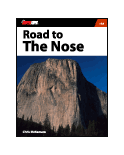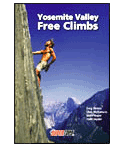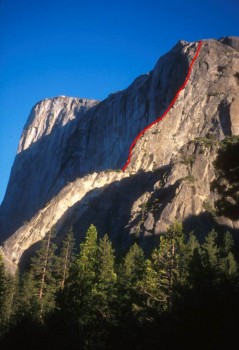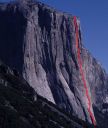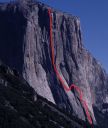East Buttress, El Capitan 5.10b |
||
Yosemite Valley, California USA | ||
| ||
|
Avg time to climb route: 6-10 hours
Approach time: 45 minutes Descent time: 2.5 hours Number of pitches: 11 Height of route: 1500' Overview
El Capitan itself conjures up fear, adrenaline, and excitement. The East Buttress of El Capitan has the potential to spawn all these emotions with far less commitment. The route is definitely a step up from the East Buttress of Middle Cathedral, but just the right size step. Not terrifically physical, the East Buttress of El Cap is long, somewhat wandering and of beautiful quality. For an especially long and challenging day, combine the East Buttress of El Cap with the Moratorium. Together they are one of the best quality link-ups in Yosemite!
Photos
- View all 39 photos of East Buttress as: Thumbnails | Slideshow
Climber Beta on East Buttress
Which SuperTopo guidebooks include a topo for East Buttress?
Find other routes like
East Buttress
History
On one side of the earth Hillary and Tenzing approached the summit of Everest. In London a princess approached the historic throne where shortly she would walk away a queen. In Yosemite three men approached a rounded non-summit, an event garnering no banner headlines, unlike the other two. But in climbing the East Buttress they would be the first ever to climb El Capitan. That week—the last days of May 1953 and the first days of June—was indeed a memorable time.One can argue that the East Buttress is not really an El Cap climb. It’s certainly not a “big wall” El Cap climb. The first ascensionists, in fact, never regarded their line as “climbing El Cap,” knowing that the real challenge began just a few yards left of their route. But most climbers feel it certainly merits an El Cap designation, though few bragging rights adhere. Exhilarated by his Sentinel and Yosemite Point Buttress first ascents, Berkeley climber Allen Steck soon turned to yet another project, this one in the El Cap area. The main face of the monolith was out of the question—too enormous and steep. But the beautiful black-and-gold buttress on the far eastern flank showed distinct cracks and chimneys on its lower section. Higher, the prospective route blended smoothly into the wall, but here also the rock looked broken and perhaps climbable. In late October 1952, Steck teamed up with three old buddies, Bill Dunmire and the two Long brothers, Bill and Dick. Dunmire led off on mixed free and aid, but about 50 feet up an aid pin popped and Dunmire plunged. To everyone’s horror, the next few pitons popped: it was Yosemite’s first “zipper” fall. The lowest pin held, however, and this saved Dunmire’s life, for he had fallen upside down, stopping just as he lightly hit the ground, which was covered with big blocks. Covered with blood and unconscious, he came to a few minutes later. Steck recalls the scene: “He had no idea where he was or what he was doing. Lost a good bit of blood, too.” Dunmire soon descended with the help of his friends and spent the night in the Valley hospital, suffering only from a bad concussion and bruised shoulder. On the next attempt, Steck and Willi Unsoeld (of later Everest fame) got much higher but a nearby waterfall began to spray them in the afternoon and Willi, in the lead, decided to come down. Steck vividly remembers what happened next: “He was about 60 feet above me, at a piton. He fiddled around with something up there and then shouted for me to lower him. I did, but at the moment he arrived the rope broke loose from above and the entire 120-foot rope fell around our feet. It turned out that Willi had attached several strands of eighth-inch parachute cord to the piton and naturally the rope had sawed through the cord. This would have been disastrous if the cord had broken earlier, but Willi was amazingly calm, telling me with his sly grin that he had planned all this out so that we wouldn’t have to pull the rope down hand over hand.” Steck went back with Unsoeld, Bill Long, and a new companion, Will Siri. Bivouacking twice on the route, and using lots of aid, the quartet suffered the indignity of a gentle rain the last two days. But basically it was an uneventful climb, and they reached the top on June 1, 1953. In July of 1964 came that now-legendary figure, Frank Sacherer, one of the boldest and finest free climbers of the mid-1960s. He and Wally Reed freed the entire route with hardly a pause. – Steve Roper Strategy
Start early as this is a long and popular climb. Luckily, several ledges allow passing. With only the slightest wind, the route is soaked by Horsetail Fall from December through May. In summer, the climb is okay if temps are below 80 degrees. Fall is ideal up until Horsetail Fall starts running.Pitch 1 contains the only mandatory chimney. Belay at the bottom of the chimney for minimum rope drag on the pumpy 5.9 top of the pitch. Pitch 2 starts with a steep and thin face crux. Trust your feet on the small edges to more secure finger and hand jams. Getting the few micro nuts up high and left is tricky and the only way to tension through the moves if they shut you down. Pitch 8 has a tricky and exposed crux. As the arête ends, move left and slightly down past the fixed pin. Look for foot smears and edges low. This crack slants diagonally such that your feet are edging and smearing while your hands are in the crack. For an especially long and challenging day, combine this with Moratorium—one of the best quality link-ups in Yosemite! Retreat
It’s easy to retreat with one 60m rope from Pitch 3. Above that there are few fixed anchors and you will have to leave gear. Carrying two ropes means leaving less gearApproach
From El Capitan Meadow, pick up the distinct trail that starts 300 feet west of El Capitan Bridge. Follow the trail to a large clearing. When facing the wall, walk at 10 o’clock and pick up the climbers' trail that eventually leads to a point 200 feet in front of the toe of the Southeast Buttress and the start of the Nose. From here, the trail diverges to skirt either the base of the Southeast Face or Southwest Face. It’s about a quarter mile and a 10-15-minute walk from the road to the toe of the Southeast Buttress and the start of The Nose. From there, it is an additional 20-30 minutes to reach the start of Lurking Fear or Zodiac.Descent
The 2-3 hour East Ledges Descent is the fastest, most convenient way to descend from El Capitan. It spares your knees the long hike down either the Yosemite Falls Trail or Tamarack Flat Trail.From the summit of most routes, hike east, staying 100 feet from the edge of El Capitan until you reach a long and distinct 30-40-foot-wide drainage just below the Zodiac finish. (For the Lurking Fear/West Buttress Finish, begin by hiking away from the edge and east until you escape slabby and brushy terrain. Then turn and head down and a little east back to the edge of El Capitan.) Follow the drainage down until 80 feet before a 2,000-foot drop-off into Horsetail Falls (often dry). Enter the manzanita bushes on a well-worn trail that after 5-10 minutes will hug the left wall. Continue along the wall until bushes end and scramble down 3rd-class terrain for about 100 feet to a ledge that is roughly perpendicular to The Wild Dikes, a south-facing black wall streaked with white. Read the following text while referencing the descent topo in the book "Yosemite Big Walls: SuperTopo": For rap routes A and B, move down 15 feet of 4th class and cut right (south) across a 20-foot wide drainage gully. Walk/slide down the right side of the gully for 30-50 feet. Exit onto the south (right) shoulder and cruise down 40 feet to a ledge. For rap route A, continue toward the edge and down a 20-foot 4th-class section to a tree wrapped with slings. For rap route B (the only route you can rap with one 60m rope), head left and down 30 feet of scree, then move right over exposed 4th-class rock. Work right, through a bush, to a 4’ x 6’ flat ledge with a small tree. Rap route C (see topo) is not recommended. From the base of the rappels, head east down multiple 3rd-class sections joined by faint trails. Eventually, a defined trail will emerge. Follow it down to a boulder strewn drainage, immediately crossing to a trail paralleling the drainage for 300 feet before it breaks off into the trees to the Manure Pile parking lot, about one mile from El Cap Meadow. If you’re caught in a storm or descending at night and are unfamiliar with the East Ledges descent, take the tedious, 4-5-hour Yosemite Falls Trail descent instead. Pick up the Falls Trail from the summit of El Capitan (see map page 42 of Yosemite Big Walls). Everything You Need to Know About
Yosemite Valley
Search the internet for beta on
East Buttress
Links to related internet pages with info on East Buttress
|
Other Routes on El Capitan
|





